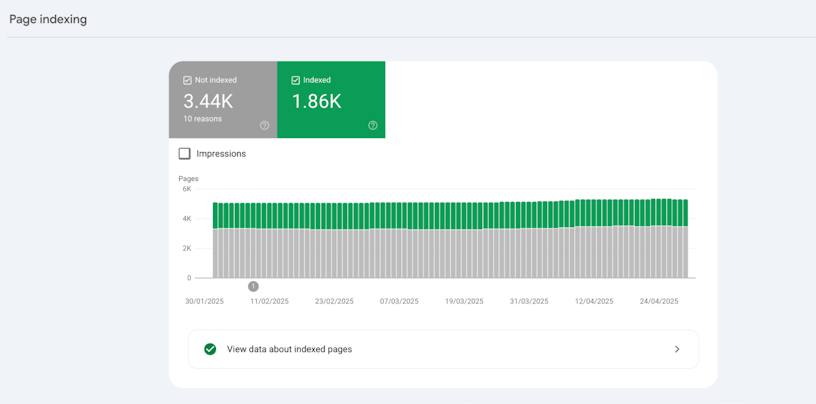For ecommerce businesses, organic search is the most sustainable and cost-effective way to drive consistent revenue. While paid ads can generate quick wins, their costs add up, and user behaviour consistently shows a preference for organic listings. That’s why ecommerce SEO isn’t just a nice-to-have; it’s fundamental to long-term success.
But even the best-optimised websites can lose traction over time without regular oversight. Search algorithms evolve, competitor activity intensifies, and technical issues can creep in unnoticed. Routine ecommerce SEO auditing helps you stay ahead, uncovering issues that may be holding your site back, identifying new opportunities, and ensuring your website performs as well as it should in search.
- What is an ecommerce SEO audit?
- Why it’s important to regularly audit your ecommerce website
- When to conduct an ecommerce SEO audit
- How to perform an ecommerce SEO audit in 4 steps
- Run a technical SEO audit
- Indexation
- Crawler control
- Site speed
- International setup?
- Structured data setup
- Pagination
- Core Web Vitals
- Mobile-friendliness
- Audit your ecommerce content
- Keyword targeting map
- Metadata
- HTML heading structure
- Content on category and product pages
- Cannibalisation?
- Informational content
- Duplicate content
- Broken links
- Review user experience (UX) and on-site behaviour
- Internal site search
- Out-of-stock products
- Audit your off-page SEO performance
- Evaluating backlinks
- Building backlinks
- Benefits of conducting an ecommerce SEO audit
- Improved search engine rankings
- Optimised marketing efforts
- More informative, user-focused content
- A better customer experience
- How often should you audit your ecommerce website?
- What is not included in an ecommerce SEO audit?
- How Impression can help you with your ecommerce SEO
Ready to improve your online store’s performance? Our ecommerce SEO specialists are well-positioned to help – get in touch today.
What is an ecommerce SEO audit?
An ecommerce SEO audit aims to provide actionable insights into a business’s organic search performance. While every audit is unique, there are a core number of on-site and off-site considerations that should be covered, from crawlability to user experience. The scope of an ecommerce audit varies depending on the size of the site and the brief, so we have created a general checklist of areas to look out for below.
If your site requires an ecommerce SEO audit and you don’t have the resources or time in place to conduct one, partnering with an ecommerce SEO agency like Impression could help.
Get in touch with the team for a free consultation or head over to our SEO auditing services page to see how we can help.
Why it’s important to regularly audit your ecommerce website
Regular audits help ensure your ecommerce site continues to meet search engine requirements, stay competitive, and deliver a great user experience. Algorithm updates, new competitors, site changes and evolving consumer behaviour all affect SEO performance. Frequent auditing means you can quickly spot and fix issues before they impact rankings or revenue.
Consumers today have high expectations for how websites perform. If your pages load slowly, contain broken links, or make checkout unnecessarily confusing, many shoppers won’t stick around — they’ll simply move on to a competitor. In fact, nearly 70% of consumers say they’re less likely to make a purchase (or return in future) if a website is too slow. And with 53% of mobile users abandoning a site that takes more than three seconds to load, the risk to sales and visibility is clear.
When to conduct an ecommerce SEO audit
Conducting regular ecommerce SEO audits is essential to ensure your site is running smoothly and staying competitive. While there’s no set “perfect time” for an audit, you should consider an audit when:
- Traffic drops significantly
- Search engine rankings decline
- Sales show a consistent decrease over several months
- Certain pages or products aren’t receiving clicks or impressions
These are signs that an audit is needed to pinpoint and address issues affecting your rankings and conversions.
How to perform an ecommerce SEO audit in 4 steps
Conducting an ecommerce SEO audit may seem complex, but breaking it down into clear steps makes the process manageable and effective. Below, we outline each stage of a thorough audit, covering everything from technical SEO to content and user experience, so you can identify and fix issues that may be limiting your organic performance.
Run a technical SEO audit
The technical health of a site is a core pillar of an ecommerce SEO strategy. The foundations of organic search performance are built on the site being crawlable and indexable to search engines, requirements that are often not met if not regularly reviewed. Websites are also judged on their site speed and mobile-friendliness.
Indexation
The Coverage tab in Google Search Console provides a useful snapshot of indexability. The dashboard provides the list of URLs that Google has crawled and their status, whether they are Valid, Excluded or Erroring. You can then dig into the specific reason behind the status of each URL and take the necessary actions to fix any issues.

Crawler control
In order to maintain crawl efficiency and avoid content cannibalisation issues, it is important to manage how search engine bots crawl your site. This can be done in the robots.txt file of a site.
Site speed
The speed at which a site loads is a ranking factor in Google’s algorithm, which is why there are a plethora of site speed auditing tools available, including PageSpeed Insights. The tool provides a score for site speed on both mobile and desktop and recommendations on how to improve.

International setup
International ecommerce websites can encounter a number of technical SEO issues, including broken hreflang tags, incorrect canonicalisation and slow server response times. There are also considerations when it comes to having your international sites on subdomains, ccTLDs or as subfolders on a .com domain. Ensure you review each of these aspects in depth before launching into new markets. For more information, check out our extensive guide to international SEO.
Structured data setup
Schema markup helps search engines better understand the intent of the page and can even earn your pages rich results in Google. Product schema is one of the best types of schema to implement as it provides extra information on the price, availability and customer ratings for your products.
Pagination
Ecommerce sites with multiple product pages need to manage pagination carefully to ensure search engines can crawl and index all content. Common issues like incorrect canonicalisation or “noindex” tags on paginated pages can affect visibility. Make sure each paginated page uses a self-referencing canonical to avoid SEO issues. For more information, check out our guide on pagination best practices.
Core Web Vitals
The Core Web Vitals (CWV) were introduced as a ranking factor in June 2021. This set of metrics measures page experience metrics, including LCP, CLS and FID. Sistrix audited the impact of the algorithm and found a distinct difference in visibility for domains that performed well for these metrics and domains that performed badly. You can create your own dashboard to audit a site’s metrics for the CWV using a CruX dashboard.

Mobile-friendliness
Mobile-friendliness is a key consideration for ecommerce website audits, as it is often the case that users will be browsing on their mobile devices rather than desktop. Google even uses mobile-first indexing, which evaluates the mobile-friendliness of the site as part of its ranking algorithm. Providing a great mobile experience is therefore paramount, and you can test this using Google’s Mobile-Friendly Test.
Audit your ecommerce content
Once the technical foundations are in place, the next step is to review your site’s content. A content audit helps identify opportunities to improve how your ecommerce site informs, persuades, and converts users. This involves analysing product descriptions, category pages, and informational content to ensure everything is optimised for both search engines and real customers. The goal is to ensure your content is relevant, keyword-targeted, and adds genuine value to the user journey.
Keyword targeting map
Carry out keyword research to understand how your target users are searching for your products or services and prioritise the queries with the most search volume. Then match the potential keywords to existing and future pages based on search intent in a keyword targeting map. This will then serve as the foundation of your content strategy.
Metadata
Meta tags play a key role in how your pages appear in search results. The title tag of the page is a ranking factor in search engine algorithms, so make sure to include the target keyword(s) wherever possible. The recommended title tag length is between 50-60 characters long as this is what Google usually shows in its results. Every page should have a unique title tag.
The meta description is not a ranking factor, but should nonetheless be optimised because engaging descriptions increase the likelihood of someone clicking onto the page. Make sure to include a CTA in the description and aim for it to be between 130-160 characters long to fit within Google’s general guidelines.
HTML heading structure
Search engines reward pages that are well structured as it helps them assess the overall relevance of the page. Ensure that every page on your website has the appropriate HTML heading structure, especially the H1 tag. The H1 tag should include the page’s main target keyword to further help search engines understand the relevance of the page.
Content on category and product pages
Well-written content supports the keyword ranking potential of category and product pages. Write unique content for each category page describing the types of products the user will find within that category. Highlight any differentiating aspects of your products, and weave in your brand messaging to ensure a consistent experience across each page. For more practical tips, see our guide to writing optimised category and product content for e-commerce.

Cannibalisation
Ecommerce sites can sometimes suffer from multiple pages competing for the same query, otherwise known as keyword cannibalisation. This is most commonly found on product pages with similar features and dimensions. An ecommerce audit will identify how to best remove this cannibalisation to give the pages the best chance of ranking.
Informational content
Ecommerce sites should seek to gain visibility throughout the conversion funnel, not just for transactional keywords. Informational content can help boost brand awareness and provide useful answers to customers at the consideration stage of their journey.
Duplicate content
Ecommerce sites often face duplicate content issues, especially from product variations or reused manufacturer descriptions. While Google doesn’t penalise this outright, it can dilute your rankings and confuse which page to prioritise. Use canonical tags or “noindex” rules to signal preferred URLs, and strengthen key pages with original content like FAQs, buyer tips, and customer reviews to stand out in search results. Read our full guide on duplicate content to learn how to identify and fix it effectively.
Broken links
Nothing disrupts the user journey like landing on a broken page. Whether it’s an internal link to a removed product or an outdated external reference, broken links harm both UX and SEO performance. As part of your content audit, scan for broken links and replace or remove them to ensure your site remains functional and trustworthy.
Review user experience (UX) and on-site behaviour
Even the best content and technical setup can fall short if the user experience isn’t up to standard. A UX audit assesses how easily users can navigate your ecommerce site, find products, and complete purchases.
Elements like site architecture, internal linking, page layout, and on-site search functionality all play a part. The aim is to remove friction from the customer journey and create a smooth, intuitive shopping experience that supports SEO and conversions.
Internal site search
Site search is a powerful tool for ecommerce websites as it provides accurate data on the exact terms their customers are using to find their most desired products. This information can be used to identify potential blocks in the user journey, as well as which products to showcase more prominently on category pages and cross-sell modules.
Out-of-stock products
Managing out-of-stock products is an important consideration for both SEO and UX. Removing out-of-stock products can affect organic visibility by losing valuable backlink equity, while also representing a missed opportunity for upselling similar products. An ecommerce audit will outline how to manage stock availability at scale to encourage conversions.
Audit your off-page SEO performance
Off-page SEO plays a crucial role in building authority and trust for your ecommerce website. This part of the ecommerce website audit focuses on external signals like backlinks, brand mentions, and domain authority, all of which impact how search engines perceive your site. Evaluating the quality, relevance, and diversity of your backlink profile helps identify opportunities for improvement, uncover toxic links that may be harming performance, and benchmark your site’s authority against competitors.
Evaluating backlinks
Backlinks remain one of the most important ranking factors in Google’s algorithm, which means it is crucial for ecommerce sites to maintain a healthy backlink profile to remain competitive in the SERPs. Regular backlink health checks should be carried out to identify any harmful links to the site and disavow them so search engines do not consider them.
Building backlinks
An ecommerce SEO audit will also scope out a layered link building strategy with top-level recommendations tailored to ecommerce link building, , including broken link recovery, unlinked mentions and reactive comment opportunities. For a more comprehensive link building strategy, consult with a Digital PR agency.
Benefits of conducting an ecommerce SEO audit
A well-executed ecommerce SEO site audit doesn’t just uncover technical issues, it lays the groundwork for long-term growth. From improving your visibility in search results to aligning your site with customer intent, here are four key benefits of running a thorough audit:
Improved search engine rankings
By identifying and resolving on-site and technical SEO issues, businesses can improve how their product and category pages appear in search. Fixing crawl errors, speeding up your site, and optimising page elements can help your ecommerce website rank higher and attract more relevant organic traffic.
Optimised marketing efforts
An ecommerce SEO audit gives you clarity on what’s working and where there are missed opportunities. Aligning your SEO findings with paid media and content marketing efforts ensures you’re targeting the right keywords, reinforcing your messaging, and supporting broader campaign goals like PPC or social.
More informative, user-focused content
Ecommerce SEO audits often uncover content gaps that, once filled, can attract informational searchers earlier in their buying journey. But content for the sake of content isn’t enough, your product-focused informational content should clearly answer key questions and guide users toward conversion with strong CTAs and product tie-ins.
A better customer experience
Beyond rankings and content, ecommerce website audits help you look at your ecommerce website through the eyes of your customer. Are pages answering the right questions? Are key product details clear and accessible? A customer-focused site structure, with useful descriptions and streamlined navigation, can dramatically boost your chances of turning visitors into buyers.
How often should you audit your ecommerce website?
The frequency of your ecommerce SEO audits largely depends on your site’s size, complexity, and market competitiveness.
A general guideline is to conduct a full audit at least once a year, covering everything from technical SEO to conversion rate analysis. For critical pages driving conversions, a content audit should be done every 3-6 months.
SEO health checks are recommended quarterly for most sites, with more frequent audits for competitive or rapidly changing industries.
What is not included in an ecommerce SEO audit?
While an ecommerce SEO audit offers a detailed review of your site’s organic search performance, there are several areas it does not typically cover. Broader strategic tasks, like in-depth competitor analysis, content marketing strategy, or comprehensive keyword research, usually fall outside the scope of a standard audit. Instead, the audit focuses on identifying on-site and technical SEO issues that may be limiting your visibility.
It’s also worth noting that ecommerce SEO audits don’t assess digital accessibility or compliance with standards such as the Web Content Accessibility Guidelines (WCAG). For those areas, a dedicated accessibility audit is needed.
How Impression can help you with your ecommerce SEO
At Impression, we’ve built a reputation as one of the UK’s leading ecommerce SEO agencies, recognised with awards like Independent Agency of the Year in the Global Agency Awards 2025, and we previously picked up the award for the Ecommerce Search Campaign of the Year for our work with Queensmith.
If you’d like to learn more about ecommerce SEO site audits and how they can help your website, check out our ecommerce SEO services or head to our SEO auditing services page to see how we can help.
Alternatively, get in touch with our team to find out more.





